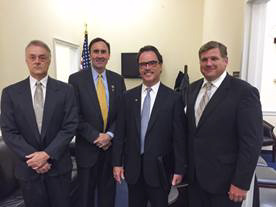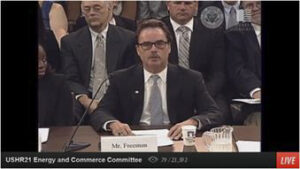Written on: June 22, 2015 by SprayTM
Mike Freeman, President of the Americas, WD-40 Co., testified on behalf of the aerosol industry before the Energy & Commerce, Power, Manufacturing, & Trade subcommittees on the U.S. Environmental Protection Agency’s (EPA) proposed revisions to the existing ozone standard on June 16. Freeman’s testimony demonstrated how the proposed changes to the National Ozone Standard would affect aerosol businesses.
Witness Testimony

Left to Right: Greg Johnson, Sherwin-Williams; Congressman Pete Olson; Mike Freeman, WD-40 Co.; and George Buckland, DS Containers (NAA President).
On June 16, the U.S. House of Representatives Committee on Energy & Commerce held a hearing titled “EPA’s Proposed Ozone Rule: Potential Impacts on Manufacturing.” The hearing was held in the Rayburn House. The hearing was called to review the issue of “under the Clean Air Act, the EPA has established the National Ambient Air Quality Standards (NAAQS) for criteria pollutants, including ground level ozone,” per U.S. House of Representatives Committee on Energy & Commerce Background definition provided during the hearing. The EPA has proposed revising the 2008 NAAQS for ground-level ozone from 75 parts per billion (ppb) to a range between 65 and 70 ppb. Building off last week’s House hearing with the EPA, the Energy & Power and Commerce, Manufacturing, & Trade subcommittees held a joint hearing to examine the EPA’s proposed revisions to the existing ozone standard and potential impacts on jobs and manufacturing.

As Congress continues to review the EPA’s proposed ozone rule, The National Aerosol Association (NAA) would like to affirm that such regulations should be based on both sound environmental science and appropriate cost/benefit assessments. Lowering the National Ambient Air Quality Standards for ozone before the current attainment level has been reached would impose prohibitive costs on the aerosol marketplace. Our experience complying with ever-increasing limits on volatile organic chemical (VOC) content has shown that the technological and commercial expenses associated with the reformulation and launch of new products is extremely steep. Such compliance will also impact the quality and performance of our products while having diminishing environmental benefits to justify such a tradeoff.